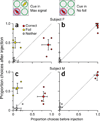Inactivation of primate superior colliculus impairs covert selection of signals for perceptual judgments
- PMID: 20023651
- PMCID: PMC3412590
- DOI: 10.1038/nn.2470
Inactivation of primate superior colliculus impairs covert selection of signals for perceptual judgments
Abstract
Primates base perceptual judgments on some sensory inputs while ignoring others. The covert selection of sensory information for perception is often thought to be accomplished mostly by the cerebral cortex, whereas the overt orienting toward relevant stimuli involves various additional structures such as the superior colliculus, a subcortical region involved in the control of eye movements. Contrary to this view, we show that the superior colliculus is necessary for determining which stimuli will inform perceptual judgments, even in the absence of orienting movements. Reversible inactivation of the superior colliculus in monkeys performing a motion discrimination task caused profound inattention for stimuli in the affected visual field, but only when distracters containing counterinformative signals appeared in the unaffected field. When distracting stimuli contained no information, discrimination performance was largely unaffected. Thus, the superior colliculus is a bottleneck in the covert selection of signals for perceptual judgments.
Figures







Similar articles
-
Changes in perceptual sensitivity related to spatial cues depends on subcortical activity.Proc Natl Acad Sci U S A. 2017 Jun 6;114(23):6122-6126. doi: 10.1073/pnas.1609711114. Epub 2017 May 22. Proc Natl Acad Sci U S A. 2017. PMID: 28533384 Free PMC article.
-
Separate signals for target selection and movement specification in the superior colliculus.Science. 1999 May 14;284(5417):1158-61. doi: 10.1126/science.284.5417.1158. Science. 1999. PMID: 10325224
-
Target selection for saccadic eye movements: direction-selective visual responses in the superior colliculus.J Neurophysiol. 2001 Nov;86(5):2527-42. doi: 10.1152/jn.2001.86.5.2527. J Neurophysiol. 2001. PMID: 11698540
-
Superior colliculus and visual spatial attention.Annu Rev Neurosci. 2013 Jul 8;36:165-82. doi: 10.1146/annurev-neuro-062012-170249. Epub 2013 May 15. Annu Rev Neurosci. 2013. PMID: 23682659 Free PMC article. Review.
-
Circuits for Action and Cognition: A View from the Superior Colliculus.Annu Rev Vis Sci. 2017 Sep 15;3:197-226. doi: 10.1146/annurev-vision-102016-061234. Epub 2017 Jun 15. Annu Rev Vis Sci. 2017. PMID: 28617660 Free PMC article. Review.
Cited by
-
Tectal microcircuit generating visual selection commands on gaze-controlling neurons.Proc Natl Acad Sci U S A. 2015 Apr 14;112(15):E1956-65. doi: 10.1073/pnas.1504866112. Epub 2015 Mar 30. Proc Natl Acad Sci U S A. 2015. PMID: 25825743 Free PMC article.
-
Neuroscience: Attention is more than meets the eye.Nature. 2012 Sep 20;489(7416):371-2. doi: 10.1038/489371a. Nature. 2012. PMID: 22996546 No abstract available.
-
A shared inhibitory circuit for both exogenous and endogenous control of stimulus selection.Nat Neurosci. 2013 Apr;16(4):473-8. doi: 10.1038/nn.3352. Epub 2013 Mar 10. Nat Neurosci. 2013. PMID: 23475112 Free PMC article.
-
Injection of a dopamine type 2 receptor antagonist into the dorsal striatum disrupts choices driven by previous outcomes, but not perceptual inference.J Neurosci. 2015 Apr 22;35(16):6298-306. doi: 10.1523/JNEUROSCI.4561-14.2015. J Neurosci. 2015. PMID: 25904783 Free PMC article.
-
Integrity of medial temporal structures may predict better improvement of spatial neglect with prism adaptation treatment.Brain Imaging Behav. 2014 Sep;8(3):346-58. doi: 10.1007/s11682-012-9200-5. Brain Imaging Behav. 2014. PMID: 22941243 Free PMC article.
References
-
- Wurtz RH, Albano JE. Visual-motor function of the primate superior colliculus. Annu. Rev. Neurosci. 1980;3:189–226. - PubMed
-
- Sparks DL. Conceptual issues related to the role of the superior colliculus in the control of gaze. Curr. Opin. Neurobiol. 1999;9:698–707. - PubMed
-
- McPeek RM, Keller EL. Deficits in saccade target selection after inactivation of superior colliculus. Nat. Neurosci. 2004;7:757–763. - PubMed
-
- Carello CD, Krauzlis RJ. Manipulating intent: evidence for a causal role of the superior colliculus in target selection. Neuron. 2004;43:575–583. - PubMed
-
- Heilman KM. Intentional neglect. Front. Biosci. 2004;9:694–705. - PubMed
Publication types
MeSH terms
Grants and funding
LinkOut - more resources
Full Text Sources
Other Literature Sources

